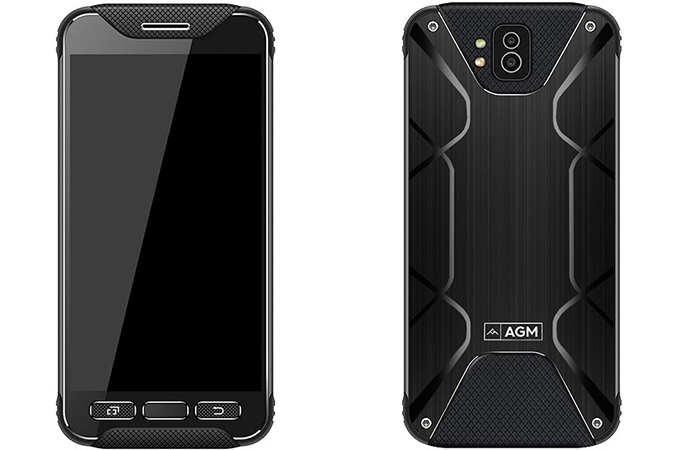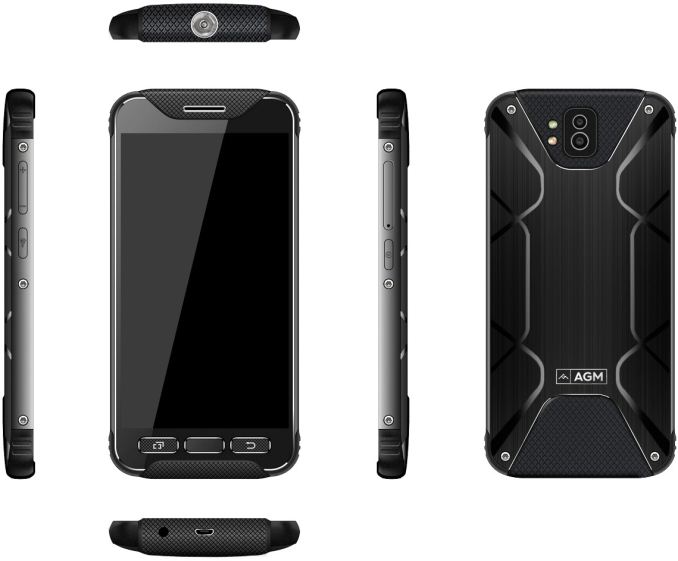MWC 2017: AGM Preparing IP68 Rated Snapdragon 835 Smartphone with 8GB DRAM
by Anton Shilov on March 13, 2017 4:00 PM EST- Posted in
- Smartphones
- Snapdragon
- Qualcomm
- Snapdragon 835
- MWC_2017
- AGM
- IP68

AGM may not be a household name for the vast majority of people living in Europe and the U.S., but this is a well-known maker of rugged phones that sells its products in many countries around the world. The company’s lineup currently includes six IP68-rated models, and in order to attract the attention of the mass market, AGM is preparing its new X2 model that weds a rugged design with the latest technology. At MWC 2017 this year, the company announced its new flagship that will be based on Qualcomm’s Snapdragon 835 and will rival leading-edge smartphones from big makers.
The Old X1
To put this into context, AGM’s current X1 flagship is based on the Qualcomm Snapdragon 617 (eight ARM Cortex-A53, Adreno 405, X8 LTE, etc.). The X1 is equipped with up to 4 GB of DDR3 RAM, up to 64 GB of eMMC NAND, two 13 MP back-facing cameras, a 5400 mAh battery and comes with a 5.5” FHD AMOLED display featuring Gorilla Glass 3. The phone is IP68-rated against dust and immersion in water (over 1 m depth, but other conditions are specified by the manufacturer), yet it looks considerably neater than typical rugged designs. While AGM’s phones come in rugged enclosures and can survive in situations when other handsets might fail, none of them are MIL-STD 810G-graded.
The New X2
While the AGM X1 is positioned by the manufacturer as an affordable rugged phone for extreme sports and other outdoor activities, but it is definitely not a phone from the premier league. In the coming months (in mid-2017) AGM plans to introduce its X2, which will be positioned as a premium smartphone and will feature Qualcomm’s latest Snapdragon 835 SoC (10nm, eight new Kryo cores, Adreno 540, X16 LTE, LPDDR4X, etc.). This is along with 8 GB of DRAM, 256 GB of NAND, two cameras, a ~6000 mAh battery (there will also be the AGM X2 Pro with a 10,000 mAh battery) an omni-bearing ambient sensor and so on. Based on official images of the AGM X2 (originally published by AGM and AndroidHeadlines), it is possible that the phone has four antennae and thus supports 4x4 MIMO, one of the three features required for Gigabit LTE.
The AGM X2 will be one of the first IP68-rated Snapdragon 835-based smartphones with a rugged design. Meanwhile, for AGM, this will be a debut on the market of premium smartphones that compete against Apple’s iPhones or Samsung’s Galaxy S-series. The price of the AGM X2 is unknown, but it will likely vary significantly depending on the store and the region. For example, the AGM X1 can be bought for $260 in China or for over $480 in the U.S.
Source: AGM
















29 Comments
View All Comments
masaad88 - Tuesday, March 14, 2017 - link
Well think about it in this way, it's a representation of how many amps you can feed the device in one hour over a certain operating voltage, which does make since.As for the voltage increase, I don't know how can they raise it, shouldn't all devices run on a fixed voltage? I assumed that SOCs and all the other components have a certain operating voltage and not different in each device.
Can anybody confirm?
Death666Angel - Wednesday, March 15, 2017 - link
@masaad88: The mAh rating does not correspond to the correspond to the ability to discharge that current in one hour. That is what the "C" rating is for. Though it is right that you can do some basic math with the mAh rating and figure out how long your device will last on that battery if you have the power draw of your device and the battery capacity in mAh available, as long as no power conversion happens. This works well for phones or small electronics like micro controllers, raspberry pis etc. Once you get to bigger electronics (PCs, Laptops) with highly variable voltages, going with Wh is the more practical way to do it. My laptop uses 8W of power, my battery has 11.1V @ 7.2Ah, which means it can be powered by battery for approx. 10 hours. Good luck trying to easily measure the amperage for each voltage and do the conversion. :)As for the one hour thing: normal NiMH AA / AAA rechargeable batteries have a C rating of .1 or .2, meaning a standard 1900mAh AA battery can be discharged at 190 mA to 380 mA. Good LiPo packs for RC usage have 10, 30, 60C, which means their rated capacity (2000mAh, 5000mAh .... ) can be multiplied by that C number and you have the max amperage they can provide in short bursts. A high C rating usually goes hand in hand with few recharge cycles and of course, rapid depletion. If a 5000mAh battery pack puts out 50A (10C), it can only last for roughly 6 minutes, give or take.
There are a lot of different battery tachnologies being deployed under the "Lithium Ion" label. Normal 18650 cells have Li2FePO4F chemistry, which translates to 3.6V average. There are other technologies which have higher or lower average voltages. And of course these are averages. A fully charged Li-Ion/LiPo battery can have 4.1V, 4.2V, 4.3V and it can be discharged to 3.3V, 3.0V or 2.8V, depending on the chemistry and build of the battery and if you value longevity of the cell or want the highest capacity for a few cycles.
The components inside the devices have fixed voltages, just like your motherboard wants 3.3V, 5V and 12V. But the Intel CPU wants 1.8V from the motherboard and then the die itself wants 1.2V. All those subsequent voltages get converted from the first 3 provided by the PSU. Same thing with modern devices, the SoC wants 1.xV, the display wants 3.3V or 5.0V etc. But they all get derived from the battery voltage, which is usually between 3.xV and 4.xV, the range depends on the chemistry and build of the cell, the desired longevity and the desired battery life claims. Some components can also run on a range of voltages, a lot of portable displays claim to run on 12V only, but can run on 7.4V 2S battery packs as well, or on 19V laptop chargers. It's not that cut and dry.
vladx - Monday, March 13, 2017 - link
For <$500 this phone is definitely worth it.bigboxes - Tuesday, March 14, 2017 - link
But it be for significantly >$500. The X-1 is $480 USD. This will be on another level.RaistlinZ - Monday, March 13, 2017 - link
Which carriers in the U.S. will this phone work with?lazarpandar - Monday, March 13, 2017 - link
That phone is simply going to be too big. If they could fit all that stuff and still a ~4000mAh into a 4.5in screened phone I'd be all over it.piroroadkill - Monday, March 20, 2017 - link
Dream on. The days of reasonably sized devices are behind us.Bullwinkle J Moose - Monday, March 13, 2017 - link
Near Native speed for UWP apps in the Windows Store is worthless to meThis phone might be useful if we could get Virtualbox as a UWP app to get around the side loading BAN Microsoft has imposed on the Snapdragon Version of Windows 10
8GB > check
Windows 10 > check
Can't run jack shit > check
Bullwinkle J Moose - Monday, March 13, 2017 - link
clarification>this particular phone may not run Windows 10, but the snapdragon 835 is Windows ready!
Murloc - Tuesday, March 14, 2017 - link
take your meds bully